
Starting a business requires money, resources, and proper guidance. Many people in India want to start their own business but face financial problems. The Prime Minister’s Employment Generation Programme (PMEGP) is a government scheme that helps new entrepreneurs by providing financial assistance. It is designed to create self-employment opportunities by helping individuals set up small businesses in both rural and urban areas. This scheme is run by the Khadi and Village Industries Commission (KVIC) at the national level, and at the state level, it is implemented by District Industries Centres (DICs), State KVIC offices, and Banks.
Table of Contents
What is PMEGP?
PMEGP is a credit-linked subsidy scheme that provides financial help to people who want to start a business but do not have enough money. Under this scheme, the government offers subsidies on loans taken from banks. This means that a part of the loan amount is given as a grant, which the beneficiary does not have to repay. The remaining loan amount has to be repaid to the bank in easy installments.
This scheme helps unemployed youth, women, artisans, and small business owners to establish their businesses and generate employment. The subsidy percentage varies depending on the location of the business and the category of the applicant. The main objective of PMEGP is to encourage self-employment, reduce unemployment, and support small-scale industries in India.
Key Features of PMEGP
| Feature | Details |
|---|---|
| Maximum Loan Amount | ₹50 lakh for manufacturing units, ₹20 lakh for service-based businesses |
| Government Subsidy | 15% to 35% of the total project cost |
| Who Can Apply? | Individuals, Self-Help Groups, Co-operative Societies, Trusts |
| Collateral-Free Loans | No collateral required for loans up to ₹10 lakh |
| Educational Requirement | Minimum 8th standard for projects above ₹10 lakh in manufacturing and ₹5 lakh in services |
| Loan Repayment Period | 3 to 7 years |
| Interest Rate | As per bank norms |
| Mandatory Training | 2-3 weeks of Entrepreneurship Development Programme (EDP) training |
Eligibility Criteria
To apply for PMEGP, the applicant must meet the following eligibility requirements:
- The applicant must be at least 18 years old.
- The applicant must have completed at least 8th standard education for projects costing above ₹10 lakh in the manufacturing sector and ₹5 lakh in the service sector.
- New businesses are eligible for this scheme. Existing businesses that have already availed financial assistance under other government schemes are not eligible.
- Self-Help Groups (SHGs) can apply, but only if they have not availed benefits from any other government scheme.
- Co-operative societies, charitable trusts, and production-based businesses in rural and urban areas can apply.
- Businesses engaged in trading activities are not eligible for PMEGP. The scheme only supports manufacturing, service, and agro-based businesses.
Loan and Subsidy Structure
The subsidy given by the government depends on the category of the applicant and the location of the business. The subsidy is higher for weaker sections of society, including Scheduled Castes (SC), Scheduled Tribes (ST), Other Backward Classes (OBC), and minorities.
| Category | Urban Subsidy (%) | Rural Subsidy (%) | Beneficiary Contribution |
|---|---|---|---|
| General Category | 15% | 25% | 10% of the project cost |
| SC/ST/OBC/Minorities, Women, Disabled, Ex-Servicemen, and NE States | 25% | 35% | 5% of the project cost |
For example, if a person from the General Category wants to start a business in an urban area with a project cost of ₹10 lakh, they will get a subsidy of ₹1.5 lakh from the government. They will have to contribute ₹1 lakh from their own funds, and the remaining ₹7.5 lakh will be given as a loan by the bank.
How to Apply for PMEGP?
The application process for PMEGP is simple and can be done online. Below are the steps to apply for the scheme:
- Visit the Official Website
- Go to the PMEGP portal: https://www.kviconline.gov.in
- Click on the “Online Application” section and select “Individual” or “Non-Individual” based on your category.
- Fill the Application Form
- Enter personal details such as name, address, date of birth, education qualification, and contact information.
- Provide business details such as project name, location, estimated cost, and type of business (manufacturing/service).
- Upload required documents like Aadhaar card, PAN card, caste certificate (if applicable), and bank details.
- Submit the Application
- After filling in the form, submit it online. You will receive an acknowledgment number that can be used to track the status of the application.
- Business Plan Submission
- A detailed project report (DPR) must be submitted along with the application. This should include business objectives, expected revenue, investment details, and employment generation potential.
- Loan Processing and Approval
- Once the application is verified, it will be forwarded to the bank for loan approval. The bank will assess the financial viability of the project before sanctioning the loan.
- Training Program
- Selected applicants must undergo a mandatory Entrepreneurship Development Programme (EDP) training for 2-3 weeks. This training helps in understanding business management, marketing, and financial planning.
- Loan Disbursement and Business Setup
- After completing the training, the loan amount is disbursed by the bank. The applicant can then start their business operations.
Types of Businesses That Can Benefit from PMEGP
PMEGP supports a variety of businesses, including:
Manufacturing Units
- Textile production
- Furniture making
- Leather products
- Food processing industries
- Handicrafts and artisan products
Service-Based Businesses
- Beauty parlors and salons
- Repair shops (electronic, mobile, vehicle)
- Courier services
- Laundry and dry-cleaning services
- Cyber cafes and IT services
Agro-Based Industries
- Dairy farming
- Beekeeping and honey production
- Organic farming
- Poultry farming
- Floriculture and nursery business
Benefits of PMEGP
- Financial Support with Subsidy – The government provides a subsidy that reduces the financial burden on entrepreneurs.
- Encourages Self-Employment – The scheme promotes entrepreneurship and self-reliance among youth, women, and marginalized communities.
- No Collateral Required – Loans up to ₹10 lakh do not require any security, making it easier for small businesses to get financial assistance.
- Promotes Rural Development – By supporting village industries and small businesses, PMEGP helps in reducing migration from rural to urban areas.
- Job Creation – Small businesses established under PMEGP generate employment opportunities for others as well.



Pingback: MUDRA Loan Yojana : How to Get a Loan Without Collateral? - Sarkari Yojana 2025
Pingback: Top 10 Indian Government Schemes for Small Businesses & Startups - Sarkari Yojana 2025